(Sample Material) Online Coaching for CAPF (AC): Geography - "Indian Geography (Part - 4)"
Online Coaching for UPSC Central Armed Police Forces (AC) Written Examination
Geography
Indian Geography (Part - 4)
Minerals in India
There are 3,168 mines in India, out of which 570 are fuel mines, 563 metallic mineral mines and 1975 non-metallic mines.
- Mineral sector accounts for 11.5% of the country’s industrial output and nearly 8% of GDP.
- The high rainfall areas of India lack in limestone, gypsum and salts which are soluble in water.
- The Himalayas have a variety of rocks but its geological structure is too complex.
- The exploitation of minerals in this mountainous terrain is not economically viable because of:
- Small quantity available at any one location
- Difficult terrain
- Lack of transportation
- Sparse population and
- Adverse climatic conditions
- Chhotanagpur Plateau is known as the mineral heart land of India.
States with the highest number of mines
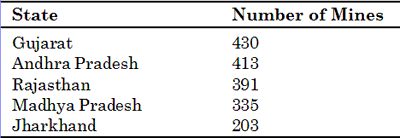
Iron Ore
- It is the backbone of modern civilisation.
- Varieties of iron ore:
- Magnetite- the best quality of iron ore and contains 72% pure iron.
- Haematite- contains 60 to 70% pure iron.
- Limonite- contains 40 to 60% pure iron.
- Siderite- contains many impurities and has just 40 to 50% pure iron.
- Jharkhand has the largest reserves accounting for about 25% of the total reserves of iron ore in India.
States and their share in iron reserves
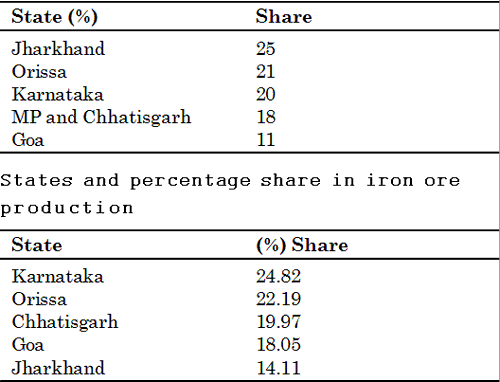
- High grade ore deposits in Karnataka are in Kemmangundi (in Bababudan hills) and Sandur & Hospet (Bellary district).
- India’s richest haematite deposits are located in Barabil-Koira valley in Orissa.
- Other important iron ore production centres are Gorumahisani, Badampahar, Kiriburu, Daitari hill (in Orissa), Bailadila and Dalli-Rajhara (in Chhattisgarh) and north Goa.
- The Bailadila mine is the largest mechanised mine in Asia from where iron ore is exported to Japan through Vishakhapatnam. Most of Goa’s iron ore is exported to Japan as well.
- India is the fifth largest exporter of iron ore in the world.
- Japan is the biggest buyer of Indian iron ore accounting for about three-fourth of our total exports.
Manganese
- India has the second largest manganese ore reserves in the world after Zimbabwe.
- India is the fifth largest producer in the world after Brazil, Gabon, South Africa and Australia.
- The main reserves are found in Karnataka, followed by Orissa, Madhya Pradesh, Maharashtra and Goa.
Production of Manganese
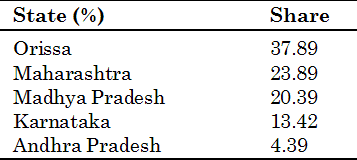
- The belt comprising Nagpur-Bhandara districts of Maharashtra and BalaghatChhindwara districts of MP is the important region for manganese ore production.
- Srikakulam (in Andhra Pradesh) is considered to be the earliest producer of manganese ore in India (1892).
- India exported manganese ore less than one fifth of the total production.
- Japan is the largest buyer of Indian manganese accounting for about two-thirds of our total exports.
Chromite
- Most of the reserves are concentrated in Orissa, Bihar, Karnataka, Maharashtra and Andhra Pradesh.
- Orissa is the largest producer, accounting for 99% of the total production, followed by Karnataka.
Copper
- India contributes to about 3.5 to 4% of the world’s total production of copper.
- Major copper ore deposits are located in Singhbhum district (Jharkhand), Balaghat district (MP) and Jhunjhunu and Alwar districts (Rajasthan).
States and their share in copper production
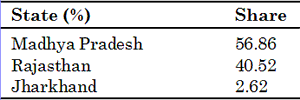
- Malanjkhand belt of Balaghat (MP) and Khetri-Singhana belt of Jhunjhunu, KhoDariba and Delwara-Kirovli area are very well known mining centres.
Bauxite Share of States in Bauxite production
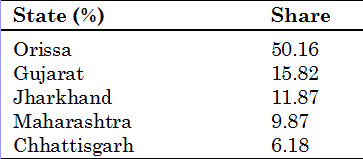
- Kalahandi and Koraput belt of Orissa is the largest bauxite bearing region of the country.
Gold
- India’s contribution to gold production across the world is less than one per cent (0.75%).
- There are mainly three gold fields in India:
- Kolar gold field in Karnataka
- Hutti gold field in Karnataka
- Ramgiri gold field in Anantapur district of Andhra Pradesh
- Karnataka is the largest producer of gold followed by Andhra Pradesh.
Miscellaneous: Other Minerals
- Diamond is found in Panna belt of Madhya Pradesh, Wajrakarur Kimberlite belt in Andandpur district of Andhra Pradesh. New kimberlite fields are discovered recently in Raichur-Gulbarga districts of Karnataka.
- Silver is mainly produced from Zawar mines of Udaipur district in Rajasthan.
- Wolfram is the ore of ‘Tungsten’. Over 95% of the wolfram is used by the steel industry. Wolfram deposits are mainly in Degana (Rajasthan) and Chendpathai in Bankura district (West Bengal).
- More than 99% of the total zinc in India is produced in Zawar area in Udaipur district of Rajasthan.
- The ore of lead is galena. Over 94% of it is produced by Rajasthan followed by Andhra Pradesh.
- Orissa has the largest deposits of Nickel.
- Karnataka is the leading state in Lead & Zinc reserves followed by Rajasthan, Maharashtra and West Bengal.
- Salt is obtained from sea water, brine springs, wells and salt pans in lakes and from rocks. Rock salt is taken out in Mandi district of Himachal Pradesh and in Gujarat. Sambhar lake in Rajasthan proeuces abut 10 per cent of our annual production. Gujarat coast produces nearly half of our salt.
Non-Metallic Minerals
- India also produces a large number of nonmetallic minerals.
Mica
- The three major types of mica found in India are - Muscovite, Phlogopite and Biotite.
- The total in situ reserves of mica are placed at 59,065 tonnes out of which -
- Andhra Pradesh has 42,626 tonnes
- Bihar and Jharkhand have 14,431 tonnes
- Rajasthan has 2006 tonnes.
- India is the world’s leading producer of sheet mica and accounts for about 60% of global mica trade due to which India is the largest exporter of mica in the world.
- About 95% of India’s mica is found in just three states of Andhra Pradesh, Rajasthan and Jharkhand.
- Nellore Belt of Andhra Pradesh and GayaHazaribagh (Jharkhand-Bihar), Giridih and Munger to Bhagalpur belt are important centres of mica production. The richest deposits of high quality ruby mica is found in Bihar-Jharkhand mica belt.
States and their share in Mica production
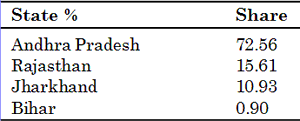
- Most of the mica exports are route( through the ports of Kolkata and Vishakhapatnam.
- Japan (19%) and USA (17%) are the major buyers of our mica.
Limestone
- Limestone deposits are of sedimentary origin and exist in almost all the geological sequences from pre-cambrian to recent except in Gondwana.
- The total in situ reserves of all categories and grades are placed at 1,69,941 million tonnes.
States’ share in Limestone reserves
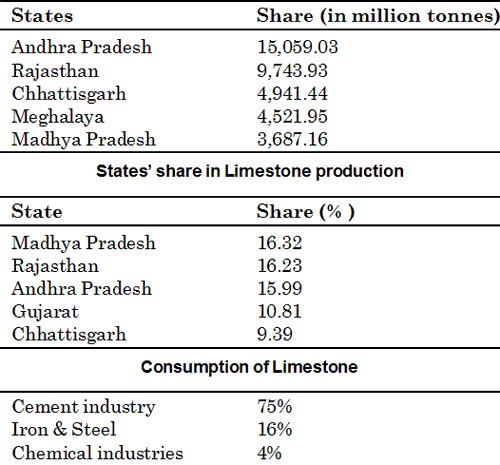
Dolomite
- Limestone with more than 10% magnesium is called dolomite, when the percentage rises to 45, it becomes true dolomite.
- Iron and Steel industry is the chief consumer of dolomite accounting for over 90% consumption followed by fertilizer (4%), ferro-alloys and glass (2%) and alloy steel (1 %).
States’ share in Dolomite production (2002-03)
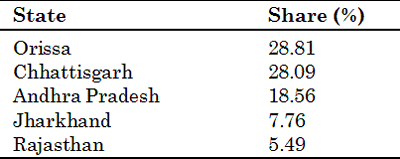
- About 90% reserves are concentrated in Madhya Pradesh, Chhattisgarh, Orissa, Gujarat, Karnataka, West Bengal, Uttar Pradesh and Maharashtra.
- Biramitrapur area is the major dolomite producing district in Orissa.
Asbestos
- Two different minerals are included under this name: Amphibole and Chrysotile.
- Chrysotile accounts for 80% of the asbestos of commercial use.
- Rajasthan is the largest producer and accounts for over 94% of the total production in India
- Andhra Pradesh is the second largest producer followed by Karnataka.
Gypsum
- It is mainly used in making ammonia sulphate fertilizer and in cement industry.
- Rajasthan is the main producer followed by Jammu and Kashmir. Rajasthan produces 99 per cent of the total production in (2002-03).
Magnesite
- Major deposits of magnesite are found in Uttrakhand, Tamil Nadu and Rajasthan.
States’ share in magnesite production (2002-03)

- Chalk Hills near Salem is the major centre for the production of magnesite in India.
Atomic Minerals
Uranium and Thorium are the main atomic minerals to which many be added i.e., beryllium, lithium and zirconium.
Uranium deposits occur in Jadugoda of Singhbhum and Hazaribagh districts of Jharkhand, Gaya district of Bihar, and in Saharanpur district of Uttar Pradesh. But the largest source of uranium comprise the monazite sands. Although monazite sands occur on east and west coasts and in some places in Bihar, the largest concentration of monazite sand is on the Kerala coast. Some uranium is found in the copper mines of Udaipur in Rajasthan. India produces about 2 per cent of world’s uranium.
Thorium is also derived from monozite. The other mineral carrying thorium is thorianite. Kerala, Jharkhand, Bihar, Tamil Nadu and Rajasthan are the main producers.
Beryllium oxide is used as a ‘moderator’ in nuclear reactors for atomic power generation. India has sufficient reserves of beryllium to meet her requirement of atomic power generation.
Lithium is a light metal which is found in lepidolite and spodumene. Lepidolite is widely distributed in Jharkhand, Madhya Pradesh and Rajasthan as well as in Bastar region of Chhattisgarh.
Zirconium is found along the Kerala coast and in alluvial rocks of Ranchi and Hazaribagh districts of Jharkhand.
Other Minerals
- India has the largest deposits of kyanite in the world.
- Jharkhand is the largest producer of Kyanite in India followed by Maharashtra and Karnataka (in descending order).
- In Sillimanite production, Orissa contributes 55.87% of the total production, followed by Kerala (32.21%) and Maharashtra (11.70%).
- The main diamond bearing areas are Panna belt in MP, Wajrakarur Kiberlite in Anantapur district and the gravels of the Krishna river basin in Andhra Pradesh.
- In salt production, rock salt is taken out in Mandi district of Himachal Pradesh. Sambhar lake in Rajasthan produces about 10 per cent of annual production. And Gujarat coast produces nearly half of our salt.
Mineral Fuels
- Coal (Black Gold)
- It constitutes about 70% of total commercial energy consumed in India. And, the power sector and industries account for 94% of total consumption.
- Coal has been described as the bridge into the future.
- India ranks third in the world after China and USA in coal production.
- Coal occurs in rock sequences mainly of two geological ages-Gondwana and tertiary deposits.
State-wise distribution of coal reserves (2005-06)
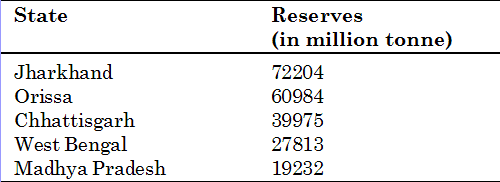
- Gondwana coal are located in coalfields occupying the Indian heartland, while tertiary coals occur in Assam, Arunachal Pradesh, Meghalaya and Nagaland.
State-wise coal production State Production (Million Tonnes)

Varieties of Coal
- Anthracite Coal - the best quality of coal and contains 80 to 95% carbon. It is found only in Jammu and Kashmir in small quantity.
- Bituminous coal -the most widely used coal and contains 40 to 80% carbon. It is found in Jharkhand, Orissa, West Bengal, Chhattisgarh and Madhya Pradesh.
- Lignite - also known as brown coal. It is a lower grade coal and contains about 40 to 50% carbon. It is found in Palna of Rajasthan, Neyveli of Tamil Nadu, Lakhimpur of Assam and Karewa of Jammu and Kashmir.
- Peat - it is the first stage of transformation of wood into coal and contains less than 40% carbon.
- The coal reserves of India as on 1 Jauary 2004 have been estimated at 2,45,693 million tonnes.
- Resource-wise, coalifields of Orissa contain the largest reserves.
- Over 90% of the lignite reserves are concentrated in Tamil Nadu. The main areas of lignite in Tamil Nadu are Neyveli, Jayamkondacholapuram and Mannargudi.
- The major coal-fields of Jharkhand are Jharia, Bokaro, Giridih and Karanpura. Jharia has been recognised as the store house of the best metallurgical coal in the country.
- Korba, Birampur, Chirimiri, Hasdo-Arand, Johilla, Jhilmili and Tatapani-Ramkola are some important coal fields of Chhattisgarh.
- Singrauli, Sohagpur, Umaria and PenchKanhan-Tawa are important coal fields of Madhya Pradesh.
- Jhingurda with a total thickness of 130 m is the richest coal seam of the country (in MP).
- The Talcher coal field in Orissa ranks second in reserves after Raniganj coal field.
- Tamil Nadu accounts for 71% of the total lignite production in India followed by Gujarat (26%).
- Coal India Ltd produces the largest quantity of coal in India followed by Singareni Collieries Comp Ltd.
Petroleum
- India produced 33.9 million tonnes of crude oil out of which 11.3 million tonnes came from on-shore sources and 22.6 million from off-shore oilfields.
Oilfields in India
- Assam is the oldest oil producing state in India.
- Digboi is the oldest oil field of India.
- Naharkatiya field, Moran-Hugriyan field are other oil-producing fields in Assam.
- Ankleshwar, Lunej, Kalol etc are important oil fields of Gujarat.
- Pt Jawahar Lal Nehru called Ankleshwar oil field the ‘fountain of prosperity’.
- Sarswati and Rajeshwari are two on-shore oil blocks in Barmer (Rajasthan) discovered recently.
- Mumbai High, Bassein and Aliabet are important off-shore oilfields in India.
Production of Petroleum
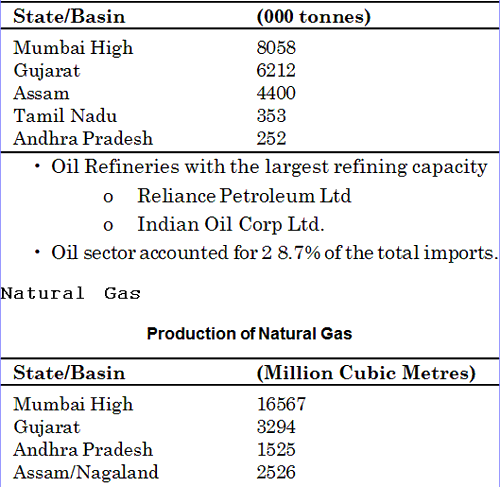
- Recent discoveries of Krishna-Godavari offshore basin and Ravva field will have a big contribution in the field of gas production in India.
- The production of natural gas has reached to 31.55 BCM in 2007 in India.
- Krishna-Godavari off-shore basin is reported to be the largest discovery of natural gas in the world in the year 2002. The wells are being drilled at depths of 1350-2700 metres which is the deepest oil exploration in India.
Pipeline
- Pipelines are most convenient, efficient and economical mode of transporting liquids like petroleum, petroleum products, natural gas, etc.
- The country had a network of about 5,035 km long pipelines in 1980 which has increased to over 7,000 km now.
Some of the important pipelines are:
- Naharkatia-Nunmati-Barauni pipeline.
- Mumbai High-Mumbai-Ankleshwar-Kayoli pipeline.
- Salaya-Koyali-Mathura pipeline
- Hajira-Bijapur-Jagdishpur (BHJ) Gas pipeline.
- Jamnagar-Loni LPG pipeline
- Kandla-Bhatinda pipeline
- Mathura-Delhi-Ambala-Jalandhar pipeline
- Haldia-Kolkata pipeline
- Chennai-Trichy-Madurai pipeline
